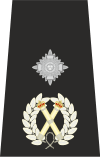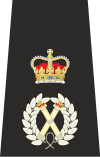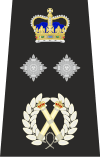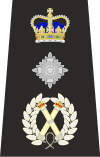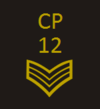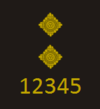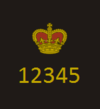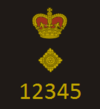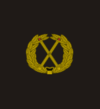Police ranks of the United Kingdom
Most of the police forces of the United Kingdom use a standardised set of ranks, with a slight variation in the most senior ranks for the Metropolitan Police Service and City of London Police.[1][2] Most of the British police ranks that exist today were chosen by Home Secretary Sir Robert Peel, the founder of the Metropolitan Police, enacted under the Metropolitan Police Act of 1829. The ranks at that time were deliberately chosen so that they did not correspond with military ranking (with the exception of Sergeant), because of fears of a paramilitary force.
In short, the ranks are from top to bottom:
- Police Constable and Sergeant
- Inspector and Chief Inspector
- Superintendent and Chief Superintendent
- Assistant chief constable, Deputy chief constable and Chief constable (outside London only).
See the variations section below for the ranks in London, Northern Island and the Isle of Man.
Rank insignia
Badges of rank are usually worn on the epaulettes. However, when in formal uniform sergeants wear their rank insignia on their upper sleeves.[1][2] When police tunics had closed collars (not open collars as worn with ties), constables and sergeants did not wear epaulettes but had their divisional call number on their collar (whence they are still often referred to as collar numbers). Sergeants wore their stripes on their upper sleeve. Inspectors and more senior ranks wore epaulettes at a much earlier stage, although they once wore their rank insignia on their collars. Most forces no longer use divisional call numbers, and retain only the collar number and rank insignia.
| Rank | Police Constable | Sergeant | Inspector | Chief Inspector | Superintendent | Chief Superintendent |
|---|---|---|---|---|---|---|
| Insignia |  |  |  |  | 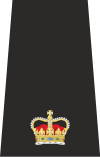 | 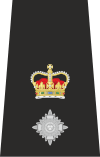 |
Senior officers usually wear distinguishing marks around the outer edge of the peaks of their caps (or under the capbadge for female officers, who do not wear peaked caps). Normally this is a raised black band for inspectors and chief inspectors, a silver (gold in the City of London Police) band for superintendents and chief superintendents, and a row of silver (gold in the City of London Police) oakleaves for chief officers. Chief constables, the Commissioner of the City of London Police, and all commissioner ranks of the Metropolitan Police wear oakleaves on both the outer and inner edges of their peaks (or a double row beneath the capbadge for female officers). In Scotland, however, the mark is a silver band for inspectors and chief inspectors, a silver band and silver oakleaves on the outer and inner edges of the peak respectively for superintendents and chief superintendents, and silver oakleaves on the outer and inner edges of the peak for all chief officers.
Additionally, officers at or above the rank of commander or assistant chief constable wear gorget patches on the collars of their tunics. The gorget patches are patterned after those worn by general officers of the British Army and Royal Marines; the police versions, however, are of silver on black (gold on black in the City of London Police) rather than gold on red, in keeping with the police uniform colours.
The above ranks are used by all territorial forces in the United Kingdom, and the specialist national forces: the British Transport Police, Ministry of Defence Police, and Civil Nuclear Constabulary.[3] Other specialist forces, and those outside of the United Kingdom (including the Channel Islands, the Isle of Man and Gibraltar) use the same general system, but often have fewer senior ranks.
Chief Constable is the title of the head of each United Kingdom territorial police force except the Metropolitan Police and City of London Police, which are headed by commissioners. Ranks above Chief Superintendent are usually non-operational management roles, and are often referred to as "Chief Officer" ranks but the longer phrase "chief police officer" or similar in legislation is specifically a commissioner or chief constable, a "senior police officer" being their immediate deputy.[4] The Commissioner of the Metropolitan Police is often considered to be the highest police rank within the United Kingdom,[5] although in reality every Chief Constable and the two Commissioners are supreme over their own forces and are not answerable to any other officer; there is also the matter that (in the absence of mutual aid arrangements and similar) a police officer of any rank only holds the office of constable in any of the three UK national jurisdiction(s) in which he/she has been attested thus implicitly limiting any general comparison or ranking to a chief police officer's home jurisdiction.
Epaulettes are normally black with white sewn on or silver metal insignia, although high-visibility uniforms are often yellow with black insignia.
Uniform insignia
The rank of an officer can be found in varying details of the uniform such as headgear, sleeve patches and tunic collar details, although these details do not vary for every rank.
| Ranks | Police Constable | Sergeant | Inspector up to Chief Superintendent | Assistant Chief Constable up to Deputy Chief Constable | Assistant Commissioner up to Commissioner (and Chief Constable) |
|---|---|---|---|---|---|
| Uniform insignia | 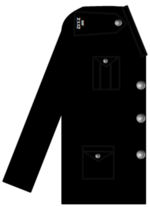 | 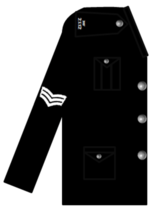 | 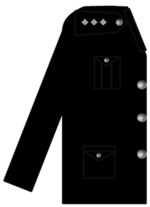 | 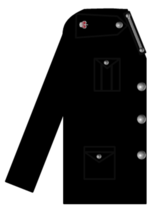 | 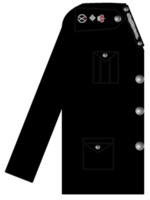 |
| Ranks | Police Community Support Officer |
Police Constable and Sergeant |
Inspector and Chief Inspector |
Superintendent and Chief Superintendent |
Commander/Asst Ch Const and Dep Asst Commr/Dep Ch Const |
Assistant Commissioner to Commissioner and Chief Constable |
|---|---|---|---|---|---|---|
| Foot patrol (male) |
|
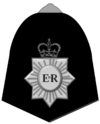 |
 |
 |
 |
 |
| Mobile patrol (male) |
 | |||||
| Foot and mobile patrol (female) |
  |  |  |  |  |  |
| Traffic officer (male) |
 |  |  | |||
| Traffic Officer (female) |
 |  |  | |||
| Police Scotland, Thames Valley Police, West Yorkshire Police and Police Service of Northern Ireland do not wear the custodian helmet, instead using the peaked cap for all duties. Hampshire Constabulary have two versions of the custodian helmet for constables and sergeants. Although not visible here, hats worn by inspectors and chief inspectors have a raised black band along the outer edge of the peak (for male officers) or a black arc below the cap badge (for female officers). | ||||||
Examples of variations
City of London Police
The City of London Police has different ranks above Chief Superintendent:
- Commander (Cmdr)
- Assistant Commissioner (AC)
- Commissioner
City of London Police insignia is gold where that of other forces is silver. For example, rank insignia and collar numbers on epaulettes are gold, as are the bands and oakleaves on the caps of senior officers, and officers of or above the rank of Commander wear gold-on-black gorget patches on the collars of their tunics.
The City of London Police also previously had variations for some acting ranks such as sergeant and inspector: acting sergeants wore their chevrons above their divisional letters (or later "CP" for all officers, following the abolition of the force's divisions), whereas substantive sergeants wear them below their collar number. Acting inspectors were denoted by a crown in the place of their divisional letters, whilst keeping their collar number and chevrons.
Royal Ulster Constabulary/Police Service of Northern Ireland
The Royal Ulster Constabulary was headed by an Inspector-General and had a different rank structure until 1 June 1970, when it fully adopted the rank system used elsewhere in the United Kingdom. The RUC has now been succeeded by the Police Service of Northern Ireland, which uses the same ranks, but has a different version of the rank insignia, with the star from the PSNI badge replacing the crown.[6] Unusually, the star is worn below the pip by chief superintendents and by the Chief Constable, who wears both symbols above his tipstaves. The PSNI has retained the RUC's distinctive inverted (point-up) sergeants' chevrons.
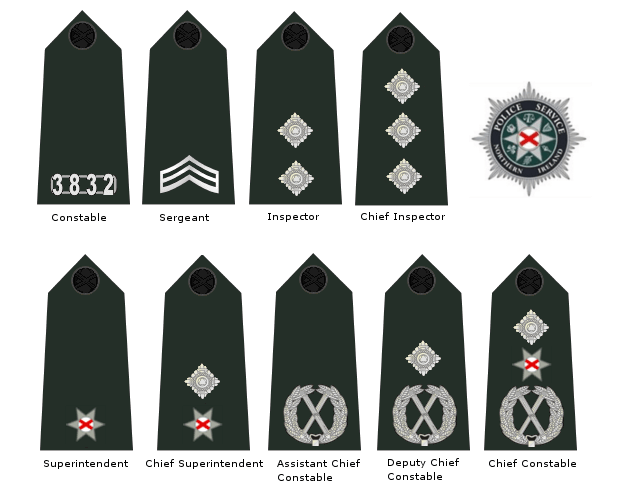
Isle of Man Constabulary
The Isle of Man Constabulary has fewer ranks above Superintendent:
Miscellaneous constabularies
There are, in the United Kingdom, a number of miscellaneous constabularies. These are not operated, regulated or funded by the Home Office, although they are fully authorised (by Act of Parliament) establishments. In general they provide the policing for ports, docks, tunnels, or other particular institutions. Although these forces tend to require high standards of training and accountability, which closely mirror those of the Home Office police forces, they are usually much smaller in terms of personnel, and therefore utilise fewer of the 'standard' ranks.
History of police ranks
All police forces have used a wide variety of ranks to meet their organisational needs, especially the Metropolitan Police Service. Ranks have been created, abolished, amalgamated and sometimes revived during the history of British policing. MET only means they are specific for the London police.

Defunct rank insignia
| Rank | War Reserve Constable |
Sub- Divisional Inspector |
Sub- Divisional Inspector |
Station Inspector |
Station Inspector |
Junior Station Inspector |
Station Sergeant |
Chief Inspector |
Chief Superin- tendent |
|---|---|---|---|---|---|---|---|---|---|
| Years active |
1939 – 1948 |
1880 – 1922 |
1922 – 1949 |
1880 – 1936 |
1936 – 1949 |
1936 – 1949 |
1890 – 1980 |
1868 – 1953 |
1949 – 1974 |
| Rank insignia |
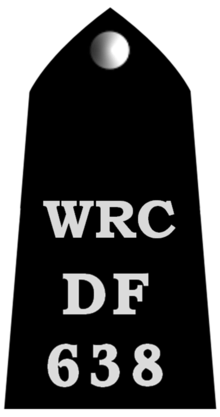 |
 |
|
 |
 |
 |
 |
|
 |
Powers
In law, every member of a police force is a Constable whatever their actual rank, in the sense that, despite being a low-ranking or high-ranking officer, all have the same powers of arrest. The basic police powers of arrest and search of an ordinary Constable are identical to those of a superintendent or chief constable; however certain higher ranks are given administrative powers to authorise certain police actions. In England and Wales, these include the powers to:
- authorise the continued detention of up to 24 hours of a person arrested for an offence and brought to a police station (granted to sergeants and above at designated police stations),
- authorise section 18 (1) PACE house searches (granted to inspectors and above), or
- extend the length of prisoner detention to 36 hours (granted to Superintendents).
Some authorities are matters of force or national or force policy and not subject to law, such as authorising the use of spike strips, and authorising the use of safe controlled crashes of pursued vehicles, by trained traffic police officers.
In relation to police officers of the Home Office or territorial police forces of England and Wales, section 30 of the Police Act 1996 states that "a member of a police force shall have all the powers and privileges of a Constable throughout England and Wales and the adjacent United Kingdom waters". Police officers do not need to be on duty to exercise their powers and can act off duty if circumstances require it (technically placing themselves back on duty). Officers from the police forces of Scotland and Northern Ireland and non-territorial special police forces have different jurisdictions. See List of police forces in the United Kingdom for a fuller description of jurisdictions.
Detectives
Officers holding ranks up to and including Chief Superintendent who are members of the Criminal Investigation Department (CID) or Special Branch (and certain other units) have the prefix "Detective" before their rank. Due to the nature of their duties, these officers generally wear plain clothes and so do not wear the corresponding rank insignia; however, they still operate within the same structure as their uniformed counterparts.
It is a misconception often portrayed by the media that detective ranks are superior to those of uniformed officers. In the United Kingdom, this is not the case, and a detective sergeant has the same powers and authority as a uniformed sergeant. The "Detective" prefix designates that the officer has a proven investigative ability and has received suitable training and passed related examinations, to conduct all manner of criminal investigations.
Trainee, temporary and acting ranks
Constables who are training to become Detective Constables sometimes bear the title Trainee Investigator (T/I) or Trainee Detective Constable (T/DC).
The prefix "Temporary" before a rank (e.g. Temporary Detective Sergeant, abbreviated T/DS) denotes an officer who has been temporarily promoted to a rank (and so who does actually hold that rank, albeit on a temporary basis), whilst the prefix "Acting" (e.g. Acting Inspector, abbreviated A/Insp) denotes an officer who is performing the role of a higher rank than the one actually held (sometimes informally termed "acting up"). Temporary ranks are often used for set periods (e.g. a six-month appointment to a particular role), whereas acting ranks, although sometimes held for extended periods, are often used for a very short time (e.g. a single shift when additional supervisory officers are required, or to replace an officer on short-term leave).
Under section 107 of the Police and Criminal Evidence Act 1984, Sergeants and Chief Inspectors may be designated (by an officer of at least the rank of Superintendent) to exercise the powers of an Inspector or a Superintendent respectively. Such a designation will generally accompany such an officer being given an acting rank, so for most operational purposes there is no difference between substantive, temporary and acting ranks at Inspector and above (although there may be differences as to pay, pensions and insignia). On the other hand, under section 36 of that Act, only substantive Sergeants may be appointed custody officers.
Identification numbers
All officers have a unique identification number. These are usually referred to as shoulder or collar numbers, referring to the fact that they were once worn on the uniform collar and later on the epaulettes by constables and sergeants. Uniformed officers in many forces still wear them on the epaulettes, but other forces have badges or other ways of displaying their identification numbers. Kent Police, for instance, refers to its numbers as force numbers and officers wear them on a velcro tab on their stab vest or on a badge attached to their shirt or tunic. Officers in all forces of the rank of inspector or above do not usually wear their numbers.
In most forces these identification numbers are simple numbers, with 1 to 5 digits.
The Metropolitan Police, being a much bigger force, uses a different system:
- Sergeant - borough code and 1, 2 or 3 digits
- Constable - borough code and 3 or 4 digits (Though Constables based in Westminster and many specialist units have 4 digits)
- Special Constable - borough code and 4 digits, usually beginning with the number 5 (8 for Traffic/Transport or 9 for specialist units)
- PCSO - borough code and 4 digits, the first digit being a 7
The borough code is a two-letter code which follows the digits (but displayed above them on epaulettes).
Before the reorganisation into boroughs, each division had a different code. A few other forces still use divisional codes.
Special constables
Special constables are volunteer police officers who have exactly the same powers as a regular officer, and (with minor exceptions) wear the same uniform and are issued the same equipment. The roles of "specials" can vary greatly from force to force, though normally include working with local regular officers to provide an additional and heightened police presence on the streets and in the local community. They may also be requested to police particular events such as football matches and community events.
In virtually all police forces, there are various grades of special constable which assist in the tasking and management of the constabulary. The ranks are management grades; those holding them are not "sergeants" or "inspectors" for the purposes of the law (for example, authorisations to order the removal of disguises or to set up roadblocks). Originally, specials held the same ranks and used the same rank insignia as regular officers, but there was a general shift to distinct terms such as "area officer" and "divisional officer" in the 1980s. However, recent national practice has been for most special constabularies to revert to the regular ranks (with the prefix "Special"), although only Merseyside Police and Wiltshire Police have reverted to regular rank insignia.
Special constabulary epaulettes frequently bear the letters "SC" (with or without a crown above) to differentiate them from regular officers. Senior special constables wear the same markings on their hats as equivalent regular ranks.
Forces using regular rank insignia
Since 2000, the National Policing Improvement Agency has encouraged special constabularies to return to rank structures and epaulette insignia identical to their regular counterparts. Although most forces have now reverted to regular rank titles, only Merseyside Special Constabulary, later followed by Wiltshire Special Constabulary and the City of London Special Constabulary have reverted to regular rank insignia. Durham Special Constabulary will move to the same rank insignia as of 1 January 2017, with the SC crown worn by officers of the rank of sergeant and above only.
| Rank | Special Police Constable | Special Sergeant | Special Inspector | Special Chief Inspector | Special Superin- tendent | Special Chief Superin- tendent | Chief Officer of the Special Constabulary |
| City of London Special Constabulary | 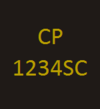 |  |  | 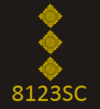 | 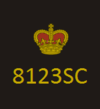 |  (Special Commander) | |
| Merseyside Special Constabulary |  |  |  |  |  |  |  |
| Wiltshire Special Constabulary |  |  |  |  |  |  | |
| Durham Special Constabulary |  |  |  |  |  |  | |
the thirty-nine other constabularies have not adopted this structure. | |||||||
Forces using "bars" rank insignia
Other special constabularies use combinations of bars, half bars, pips, crowns, laurel wreaths, collar numbers, force crests and the SC identity (with or without a crown) to distinguish ranks (and/or role).
Police Community Support Officers (PCSO)

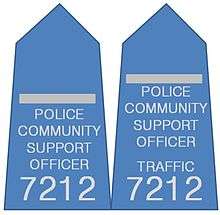
Police Community Support Officers in general do not have a rank system: their epaulettes simply bear the words "POLICE COMMUNITY SUPPORT OFFICER" and their shoulder number, or, in the Metropolitan Police, a borough identification code and shoulder number.
South Yorkshire Police and Kent Police have PCSO Supervisors. In South Yorkshire they wear a bar above the words "Police Community Support Officer Supervisor" and the shoulder number.
Traffic wardens
Traffic wardens are administered by the police and exercise some police powers to control traffic or issue fixed penalty notices for traffic offences; their epaulettes bear their shoulder number and the words TRAFFIC WARDEN. They are not to be confused with local authority civil enforcement officers (formerly parking attendants) who, under decriminalised parking enforcement, have powers to issue fixed penalty notices for breaches of parking laws on highways or in local authority car parks and compel the production of a disabled parking permit (blue badge) for inspection.
References
- 1 2 "Badges of Rank". Metropolitan Police Service. Retrieved December 1, 2011.
- 1 2 Thames Valley Police: Uniformed police ranks
- ↑ CNC ranks listed here on their website.
- ↑ Police Reform and Social Responsibility Act 2011
- ↑ Stephenson is named new Met Police chief, The Independent
- ↑ Police Service of Northern Ireland: Badges of Rank

